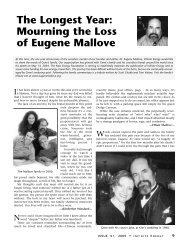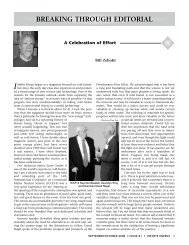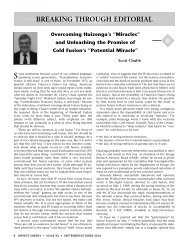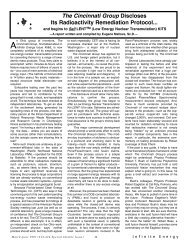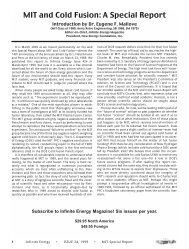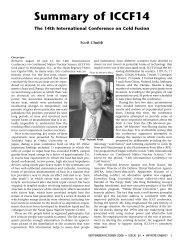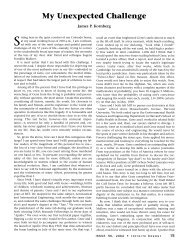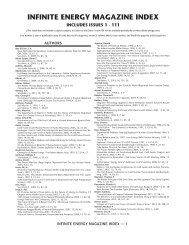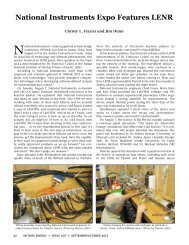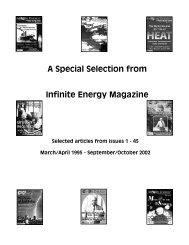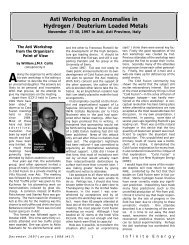Martin Fleischmann's Historic Impact - Infinite Energy Magazine
Martin Fleischmann's Historic Impact - Infinite Energy Magazine
Martin Fleischmann's Historic Impact - Infinite Energy Magazine
You also want an ePaper? Increase the reach of your titles
YUMPU automatically turns print PDFs into web optimized ePapers that Google loves.
fusion program. He and <strong>Martin</strong> were both outstanding<br />
speakers and debaters. One example that I recall well is that<br />
<strong>Martin</strong> claimed that cold fusion had already demonstrated<br />
energy breakeven, whereas hot fusion had years to go before<br />
it could claim that. Harold responded by saying that<br />
<strong>Martin</strong>’s definition of breakeven was faulty, and that his<br />
experiments themselves were faulty. I tried to stay out of<br />
that debate, but in my talk I did inject some thoughts following<br />
up on <strong>Martin</strong>’s testimony. One was to suggest that<br />
use of a deuterium-tritium electrolyte might produce copious<br />
14 MeV neutrons, providing a cold fusion neutron<br />
source. During a break in the hearing, <strong>Martin</strong> approached<br />
me and said that it was an interesting question, but he was<br />
convinced that such a neutron source would not work. In<br />
any case, this first personal meeting with <strong>Martin</strong> turned out<br />
to be one of many. Our paths crossed at various<br />
International Conference on Cold Fusion (ICCF) meetings,<br />
and also at a series of meetings in Italy. <strong>Martin</strong> was an advisor<br />
to the cold fusion group at the Frascati INEA laboratory<br />
outside of Rome so he made frequent trips there. <strong>Martin</strong> is<br />
well known as a leader in electrolytic experiments and theory,<br />
but I found his overall knowledge of science was spectacular.<br />
In addition, he was always quite willing to discuss others’<br />
research. Thus I described aspects of my LENR work to<br />
him several different times and he was quite willing to listen<br />
and provide advice. Indeed his advice was often right on and<br />
I implemented some of his suggestions into my work.<br />
There is no doubt that <strong>Martin</strong>’s work with Pons has<br />
already had a great effect on the scientific community by<br />
bringing scientists from over the world to the field despite<br />
the turmoil that developed around the original public<br />
announcement. I am now convinced, as many others in the<br />
field are, that their experiment will be shown beyond any<br />
doubt to have been correct. Their work will be recognized as<br />
the start of this new field of condensed matter nuclear science,<br />
which appears destined to play a large part in society’s<br />
future energy sources. All of the unfortunate attacks on<br />
Fleischmann and Pons will be forgotten while their tremendous<br />
contribution to society will be remembered in future<br />
histories of science.<br />
Dr. Irina Savvatimova<br />
(Scientist, Federal State Unitary Enterprise LUCH)<br />
<strong>Martin</strong> Fleischmann has influenced the work of every scientist<br />
involved in cold fusion research. There is no doubt<br />
that Fleischmann and Pons took a great risk in announcing<br />
this new direction of research. It is thanks to their courage in<br />
communicating with the press and the world scientific community<br />
that the new era of cold fusion research began.<br />
Immediately with the March 23, 1989 announcement,<br />
many scientists remembered encountering their own unusual<br />
anomalous effects related to physical processes (plasma<br />
electrolysis, gas discharge, etc.). More than twenty years<br />
before, Russian scientist B.V. Bolotov registered neutron<br />
emission during electrolysis; A.S. Filimonenko suggested the<br />
device for changing radioactivity. But only Fleischmann<br />
publicly announced to the world that there was a possibility<br />
to synthesize elements using low-energy processes. It was a<br />
very bold statement at that time, but also boldness of thinking.<br />
Many researchers were inspired by his and Pons’ public<br />
statement and immediately remembered their unusual<br />
results and resumed the research in this field with their own<br />
background, experience, results and opportunities.<br />
We (Kucherov, Karabut, Savvatimova) shared this fate. As<br />
soon as we heard the announcement, we started to actively<br />
study the plasma effect registration in the glow gas discharge.<br />
I had previously researched the damage effects of the<br />
first wall of a thermonuclear reactor by low-energy hydrogen<br />
and deuterium ions. I used the glow discharge as the source<br />
of low-energy hydrogen and deuterium ions. The parameters<br />
of the most intense damage effects had been identified.<br />
Therefore we had all the necessary equipment for this<br />
process, including palladium, hydrogen and deuterium, and<br />
were ready to begin deep study of the physical process<br />
accompanying cold fusion phenomena. And when Yan<br />
Kucherov asked to look at my installation, I understood that<br />
he would offer to involve in me in cold fusion research. He<br />
did and I said: “Yes.” After the visit, they promised to find me<br />
a device for registration of neutrons and within a few days<br />
we registered neutrons after switching off the gas discharge.<br />
This was the effect which Fleischmann called very exactly<br />
“life after death.” We were very excited and could not sleep<br />
(Kucherov and I experienced similar feelings). After a month,<br />
we sent the results for publication in the Russian journal<br />
Uspekhi Phyizicheskikh Nauk (Advance in Physical Science). Our<br />
paper was rejected and returned to us with the inscription,<br />
“Not approved for publication.” After that we filed two applications<br />
for patents: on the application of glow discharge as a<br />
source of neutrons (we got approved) and on the use of glow<br />
discharge as a source of heat (we did not get approved). At<br />
first application we received an inventor’s certificate.<br />
This work did not bring me any advance in my career and<br />
no increase in my salary. However, thanks to cold fusion I<br />
met many scientists who did research in this direction, not<br />
only in Russia but around the world. I met an enormous<br />
number of scientific enthusiasts willing to spend their own<br />
funds for research on the study of cold fusion phenomena. I<br />
am so thankful for this fate of mine and of course to<br />
Fleischmann personally.<br />
Absolutely the name of <strong>Martin</strong> Fleischmann will remain<br />
in the hearts and souls of the scientists who were inspired by<br />
him to work in cold fusion. Undoubtedly our positive results<br />
in this direction, including a 1992 publication in Physics<br />
Letters, were initiated by the Fleischmann-Pons activity.<br />
Dr. Pamela Mosier-Boss<br />
(Chemist/Visiting Scientist, Massachusetts Institute of Technology)<br />
The world has lost a great man of extraordinary vision,<br />
curiosity, humor and courage. <strong>Martin</strong> Fleischmann has<br />
impacted the work of many, including me, and he will be<br />
sorely missed. He discovered the giant Raman effect, which<br />
later became known as surface enhanced Raman spectroscopy<br />
(SERS). SERS holds the promise of detecting and<br />
identifying ultra low concentrations of molecular species. He<br />
pioneered the field of in situ spectroelectrochemistry, which<br />
enabled scientists to determine electrochemical reaction<br />
mechanisms by monitoring the spectral changes of the electroactive<br />
species on the electrode. He pioneered the use of<br />
ultramicroelectrodes (UMEs), which allowed us to probe<br />
electrochemical reactions in the gas phase, solids including<br />
ice, and in brain cells. He was the first to demonstrate the<br />
use of fiber optics to obtain Raman spectra.<br />
SEPTEMBER/OCTOBER 2012 • ISSUE 105 • INFINITE ENERGY 10



